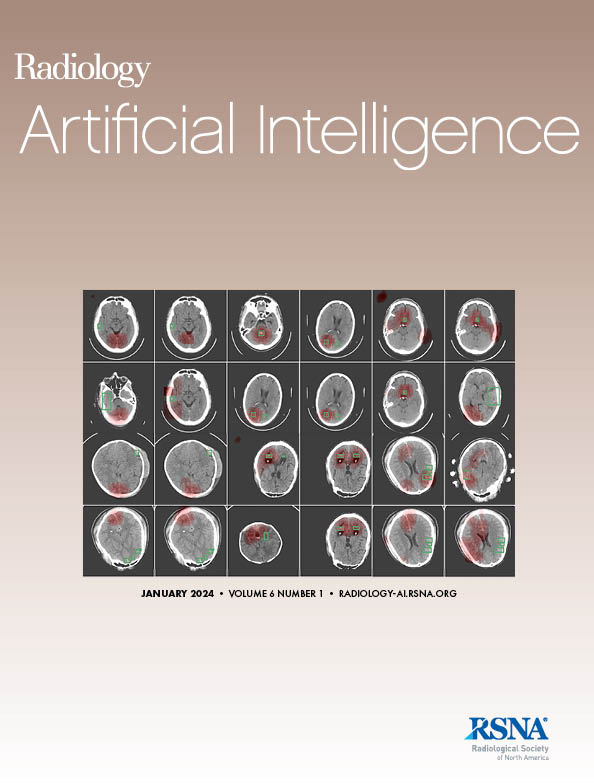Adam E Flanders, Xindi Wang, Carol C Wu, Felipe C Kitamura, George Shih, John Mongan, Yifan Peng
下载PDF
{"title":"The Evolution of Radiology Image Annotation in the Era of Large Language Models.","authors":"Adam E Flanders, Xindi Wang, Carol C Wu, Felipe C Kitamura, George Shih, John Mongan, Yifan Peng","doi":"10.1148/ryai.240631","DOIUrl":null,"url":null,"abstract":"<p><p>Although there are relatively few diverse, high-quality medical imaging datasets on which to train computer vision artificial intelligence models, even fewer datasets contain expertly classified observations that can be repurposed to train or test such models. The traditional annotation process is laborious and time-consuming. Repurposing annotations and consolidating similar types of annotations from disparate sources has never been practical. Until recently, the use of natural language processing to convert a clinical radiology report into labels required custom training of a language model for each use case. Newer technologies such as large language models have made it possible to generate accurate and normalized labels at scale, using only clinical reports and specific prompt engineering. The combination of automatically generated labels extracted and normalized from reports in conjunction with foundational image models provides a means to create labels for model training. This article provides a short history and review of the annotation and labeling process of medical images, from the traditional manual methods to the newest semiautomated methods that provide a more scalable solution for creating useful models more efficiently. <b>Keywords:</b> Feature Detection, Diagnosis, Semi-supervised Learning © RSNA, 2025.</p>","PeriodicalId":29787,"journal":{"name":"Radiology-Artificial Intelligence","volume":" ","pages":"e240631"},"PeriodicalIF":13.2000,"publicationDate":"2025-07-01","publicationTypes":"Journal Article","fieldsOfStudy":null,"isOpenAccess":false,"openAccessPdf":"https://www.ncbi.nlm.nih.gov/pmc/articles/PMC12319696/pdf/","citationCount":"0","resultStr":null,"platform":"Semanticscholar","paperid":null,"PeriodicalName":"Radiology-Artificial Intelligence","FirstCategoryId":"1085","ListUrlMain":"https://doi.org/10.1148/ryai.240631","RegionNum":0,"RegionCategory":null,"ArticlePicture":[],"TitleCN":null,"AbstractTextCN":null,"PMCID":null,"EPubDate":"","PubModel":"","JCR":"Q1","JCRName":"COMPUTER SCIENCE, ARTIFICIAL INTELLIGENCE","Score":null,"Total":0}
引用次数: 0
引用
批量引用
Abstract
Although there are relatively few diverse, high-quality medical imaging datasets on which to train computer vision artificial intelligence models, even fewer datasets contain expertly classified observations that can be repurposed to train or test such models. The traditional annotation process is laborious and time-consuming. Repurposing annotations and consolidating similar types of annotations from disparate sources has never been practical. Until recently, the use of natural language processing to convert a clinical radiology report into labels required custom training of a language model for each use case. Newer technologies such as large language models have made it possible to generate accurate and normalized labels at scale, using only clinical reports and specific prompt engineering. The combination of automatically generated labels extracted and normalized from reports in conjunction with foundational image models provides a means to create labels for model training. This article provides a short history and review of the annotation and labeling process of medical images, from the traditional manual methods to the newest semiautomated methods that provide a more scalable solution for creating useful models more efficiently. Keywords: Feature Detection, Diagnosis, Semi-supervised Learning © RSNA, 2025.
大语言模型时代放射学图像标注的演变
“刚刚接受”的论文经过了全面的同行评审,并已被接受发表在《放射学:人工智能》杂志上。这篇文章将经过编辑,布局和校样审查,然后在其最终版本出版。请注意,在最终编辑文章的制作过程中,可能会发现可能影响内容的错误。尽管用于训练计算机视觉人工智能模型的多样化、高质量的医学成像数据集相对较少,但包含可重新用于训练或测试此类模型的专业分类观察结果的数据集就更少了。传统的注释过程既费力又耗时。重新利用注释和整合来自不同来源的类似类型的注释从来都不现实。直到最近,使用自然语言处理将临床放射学报告转换为标签需要对每个用例的语言模型进行定制培训。大型语言模型等新技术使得仅使用临床报告和特定提示工程就可以大规模地生成准确和规范化的标签成为可能。从报告中提取和规范化的自动生成标签与基础图像模型相结合,提供了一种为模型训练创建标签的方法。本文简要介绍了医学图像注释和标记过程的历史和回顾,从传统的手动方法到最新的半自动方法,这些方法为更有效地创建有用的模型提供了更具可扩展性的解决方案。©RSNA, 2025年。
本文章由计算机程序翻译,如有差异,请以英文原文为准。

 求助内容:
求助内容: 应助结果提醒方式:
应助结果提醒方式:


